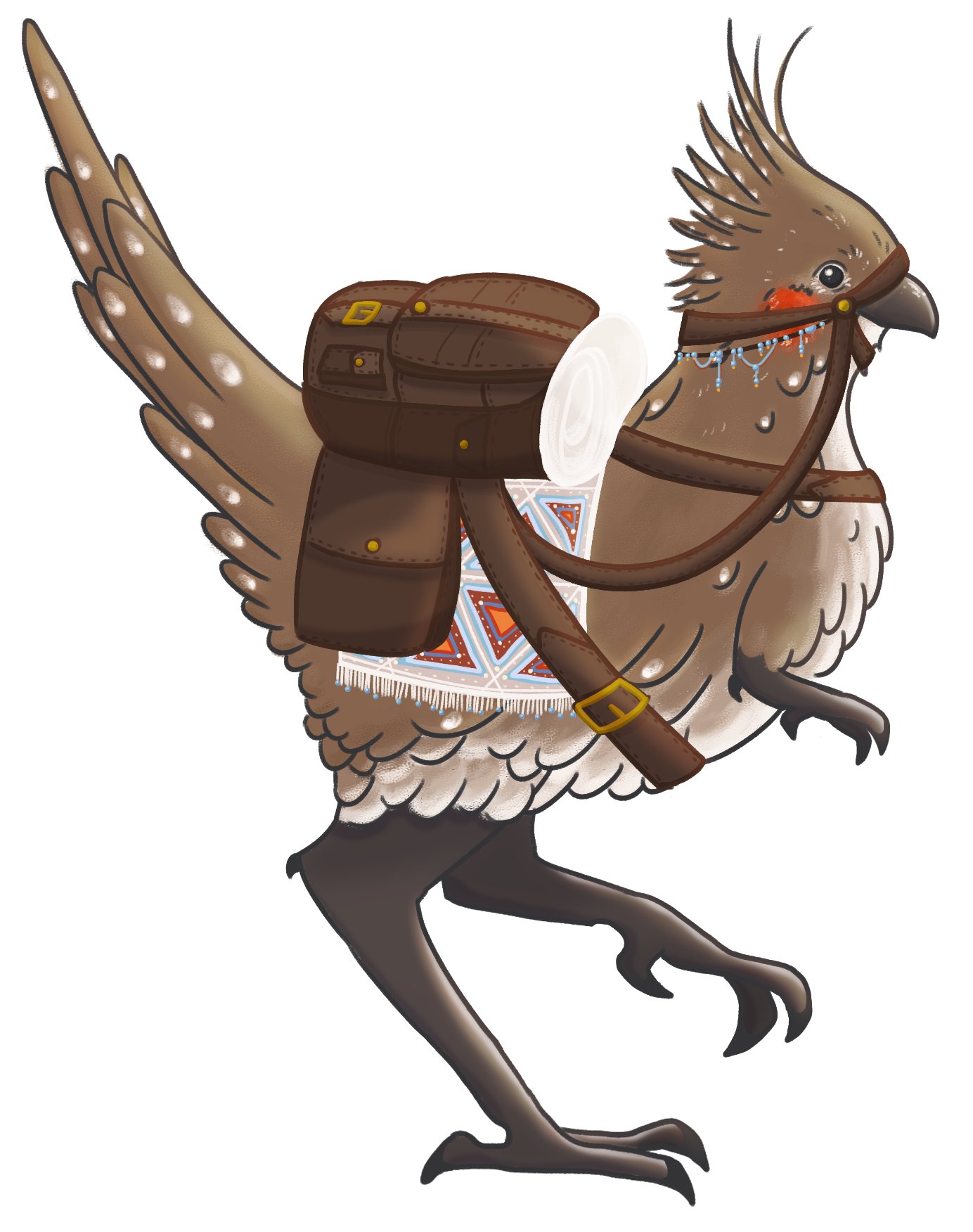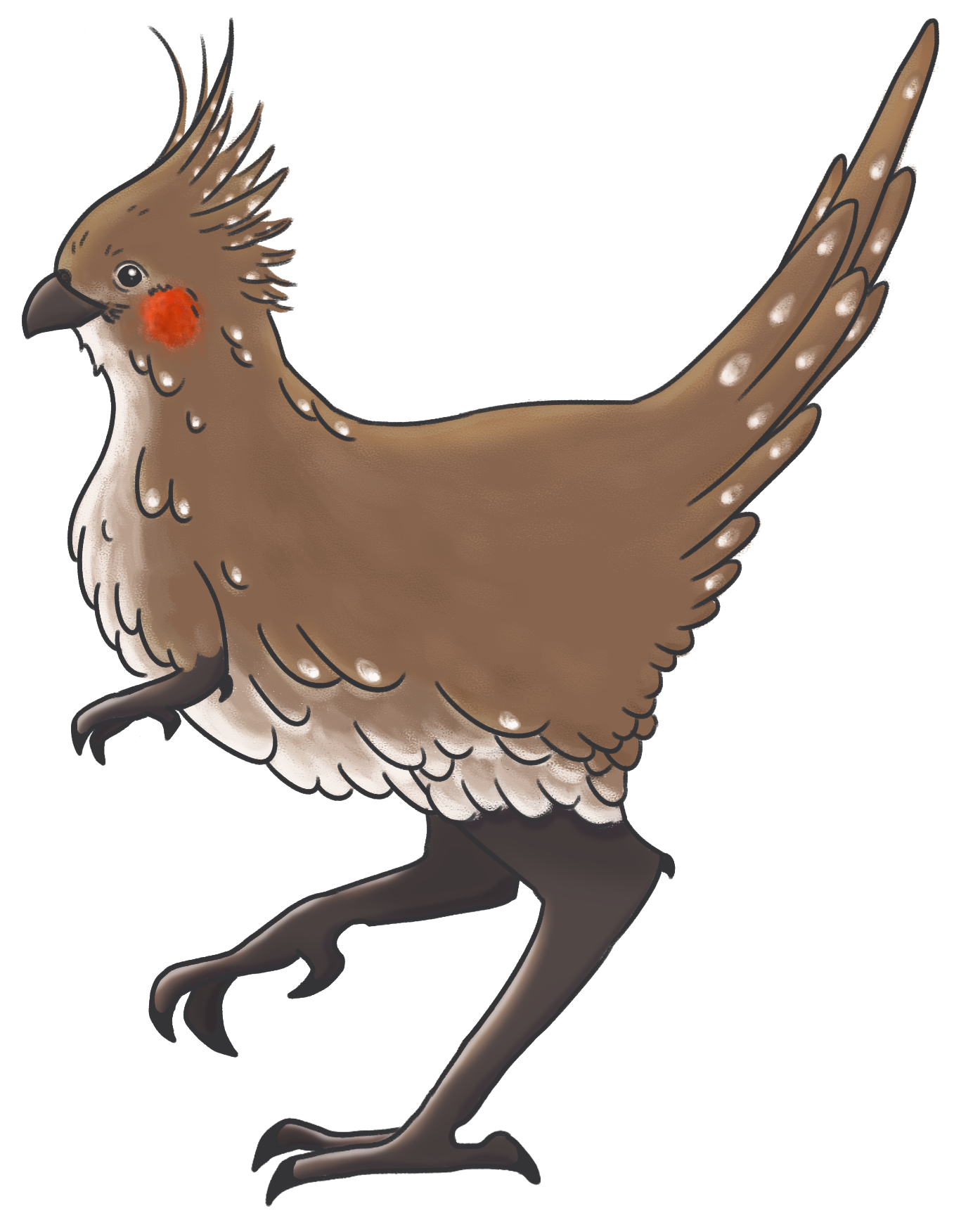Kayu
With two strong legs and small stumps for arms, the large bird, Kayu, stands roughly 3 meters tall and is one strong beast. The thing that separates them from most other mount-like creatures is their incredibly meaty and strong legs, which makes them able to walk and run for hours without tiring.
The Kayu is a bipedal herbivore and is definitely in the avian family as they have a lot of similarities. With its comparably small toothless beak and feathered body, the Kayu is in many ways a large muscular bird - well it would then be the largest bird. That having said, they have no longer any wings on their body, but it is believed that they might have had something that resembled wings long ago. They stand on their two strong back legs, whereas their front legs/arms are more for grabbing and holding.
They can carry up to two fully grown humans on their backs at the same time and a backpack plus satchel attached to their backs. If they only have to transport goods, a bigger backpack is attached, and a lot can be carried that way.
Underneath their backpacks and saddles, a finely woven blanket is placed to make it more comfortable for the large creature and to make sure it doesn't leave deep marks on their backs as they carry heavy cargo.
It has been documented many times now, so many that it isn't seen as anything strange or interesting anymore. The Kayu is good at connecting with other species, and also with their own kind. They are super empathetic and understands basic emotions - even has their own way of showing emotions.
This means that many have a strong bond with their mount, and has become a part of the family, just like a dog or a cat would. Because of the long life expectancy, the Kayu is for many a lifelong friend or family member. They regard their humans as a part of their family as well, and they mourn just like we do if they lose their human companion.
Many get their first Kayu as young adults, and will often only have one or two during their entire life. As their Kayu gets older, they retire them so they'll get at least 5-10 years in peace and harmony with the rest of their flock.
Compainions for life, the Kayu is a great addition to the family and will follow you faithfully through thick and thin.
Anatomy and appearance
The Kayu is a bipedal herbivore and is definitely in the avian family as they have a lot of similarities. With its comparably small toothless beak and feathered body, the Kayu is in many ways a large muscular bird - well it would then be the largest bird. That having said, they have no longer any wings on their body, but it is believed that they might have had something that resembled wings long ago. They stand on their two strong back legs, whereas their front legs/arms are more for grabbing and holding.
Feathers
The Kayu is covered in soft and shiny feathers from their head to their tail, mostly in natural brown colours, apart from a patch of red/orange feathers located on the cheek. On its head, long feathers emerge with small white dots on and curl upwards a bit. The same white dots can be seen sporadically on the feathers, all the way to the tail feathers where they become more frequent. The stomach and front of the feathers are lighter and almost white for some of the Kayu.Human importance
Transportation
The strong creature is used as a mount and transportation animal for human transportation and to transport small amounts of goods. Rough terrain and shifting temperatures don't bother the Kayu, which makes them perfect as a mount through most parts of Aewyn. They've been used and bred as a mount for many centuries and were first used in the Lakaian lowlands, where they natively live.They can carry up to two fully grown humans on their backs at the same time and a backpack plus satchel attached to their backs. If they only have to transport goods, a bigger backpack is attached, and a lot can be carried that way.
Underneath their backpacks and saddles, a finely woven blanket is placed to make it more comfortable for the large creature and to make sure it doesn't leave deep marks on their backs as they carry heavy cargo.
Companionship
Look Friid! I made you a new blanket! Do you like the colours? - Happy chirp sounds comes from large Kayu
It has been documented many times now, so many that it isn't seen as anything strange or interesting anymore. The Kayu is good at connecting with other species, and also with their own kind. They are super empathetic and understands basic emotions - even has their own way of showing emotions.
This means that many have a strong bond with their mount, and has become a part of the family, just like a dog or a cat would. Because of the long life expectancy, the Kayu is for many a lifelong friend or family member. They regard their humans as a part of their family as well, and they mourn just like we do if they lose their human companion.
Many get their first Kayu as young adults, and will often only have one or two during their entire life. As their Kayu gets older, they retire them so they'll get at least 5-10 years in peace and harmony with the rest of their flock.



